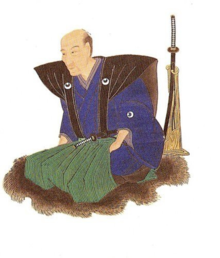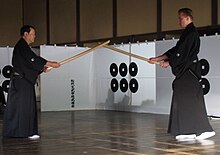Hokushin Itto-ryu
The Hokushin Ittō-ryū Hyōhō ( Japanese 北辰 一刀 流 兵法 ) is an old Japanese fencing school of the category Koryū ( 古 流 ). It was founded towards the end of the Edo period in 1821 by Chiba Shūsaku Narimasa ( 千葉 周作成 政 , 1794-1856). He was one of the last masters to be dubbed Kensei (sword saint).
Curriculum and characteristics
The school curriculum mainly contains Kenjutsu , Battojutsu , Naginatajutsu and Jiu Jitsu . However, the focus is on the use of the long and short sword ( katana and wakizashi ).
The Hokushin Ittō-ryū is a dueling school that focuses on simple, fast techniques that do not involve unnecessary movements. Breaking the opponent's center line with the Kiri-Otoshi and dominating the opponent with very fast stabbing techniques are the characteristic techniques of this school. The tenet of Hokushin Ittō-ryū is that a perfect technique involves defense and attack in a single movement.
Another characteristic of the training is the use of onigote (heavily padded training gloves ), which are used in various kumitachi kata (partner exercises). However, with the advent of Bogu and Shinai, this training fell more and more.
This style is one of the few remaining ryūha who practice kumitachi with shinken (sharp swords). It is required that a student for filing his Shihan test ( Chumokuroku / Menkyo each technique) Shinken has mastered (and Kumitachi Battojutsu). This dangerous condition guarantees that the ability of every Shihan is kept at a very high level.
Personalities
Towards the end of the Bakumatsu period (1853-1867) the Hokushin Ittō-ryū was one of the three largest and most famous schools in all of Japan. Students of the Hokushin Ittō-ryū also had a great influence on the development of modern Kendō in the late 19th century. The school also produced many famous and influential people.
Some of the most famous names:
- Sakamoto Ryoma , famous revolutionary
- Itō Kashitarō, Shinsengumi military advisor
- Yamaoka Tesshū , founder of the Ittō Shōden Mutō-Ryū
- Chiba Sana, daughter of the 1st Chiba Dōjō head
- Yamanami Keisuke , Shinsengumi Vice Commander
- Tōdō Heisuke , Commander of the 8th Division of the Shinsengumi
- Kiyokawa Hachirō, founder of the Kiyokawa School and Roshigumi
- Yoshimura Kanichirō, Shinsengumi Kenjutsu teacher
- Negishi Shorei, 13th Sōke of the Annaka-han Araki-ryū and founder of the Negishi-ryū (Shurikenjutsu)
- Okada Sadagoro, well-known fencer of the Bakumatsu and Meiji periods and 14th Sōke of Annaka-han Araki-ryū
- Naitō Takaharu , one of the key figures in the development of modern kendō
- Takano Sasaburō , one of the key figures in the development of modern kendō
- Monna Tadashi , one of the key figures in the development of modern kendo
- Mochida Moriji , one of the most famous kendō teachers of the 20th century
Graduation system
The Hokushin Ittō-ryū has three levels of teaching:
- Shoden 初 伝 (beginning of tradition, beginner)
- Chūden 中 伝 (middle of tradition, advanced)
- Okuden 奥 伝 (end of tradition, master)
Like many other Koryū, the Hokushin Ittō-ryū retained their traditional grading system. There are no modern graduations such as Dan and Kyu degrees. The school still awards Makimono (scrolls) and Inka-jō ( Menjō / certificates) The five traditional Hokushin Ittō-ryū scrolls are:
- Kirigami 剪紙
- Hatsu-Mokuroku 初 目録
- Kajō-Mokuroku / Seigandenju 箇 条 目録 / 星 眼 伝 授
- Chū-Mokuroku / Menkyo 中 目録 / 免 許 (complete tradition of all techniques)
- Dai-Mokuroku / Menkyo-Kaiden 大 目録 / 免 許 皆 伝 (complete tradition of the style)
In addition to these, there is the so-called Naginata-Mokuroku 長刀 目録 which requires the mastery of all Naginatajutsu techniques. The Naginata-Mokuroku is usually given together with the Chu-Mokuroku.
genealogy
Main lines
There were two main lines in the Edo period. One was that of the style founder Chiba Shūsaku Narimasas and his Edo-Genbukan, the other is that of his brother Chiba Sadakichi Masamichis and his Chiba-Dōjō. The Edo-Genbukan lineage died out in the middle of the Meiji period. The line of the Chiba-Dōjō still exists today and is led by Ōtsuka Ryūnosuke Masatomo as the 7th Sōke .
Edo-Genbukan (extinct)
- Chiba Shūsaku Narimasa
- Chiba Kisotaro Takatane
- Chiba Eijirō Nariyuki (led the Edo Genbukan until his death in 1862)
- Chiba Michisaburō Mitsutane
- Chiba Shūnosuke Koretans
Chiba Shûnosuke Koretans restored the Edo genbukan with the help of Yamaoka Tesshū and Inoue Hachirō in 1883. He was the last head of the Edo genbukan. The Edo Genbukan was closed around the 20th - 30th years of the Meiji period under Chiba Shūnosuke Koretans. The exact date is not known.
Chiba-dojo
- Chiba Sadakichi Masamichi
- Chiba Jūtaro Kazutane
- Chiba Tō-ichirō Kiyomitsu
- Chiba Tsukane
- Chiba Hiroshi Masatane
- Ōtsuka Yōichirō Masanori
- Ōtsuka Ryūnosuke Masatomo
On July 1, 2013, Ōtsuka Yōichirō Masanori of the 5th Soke, Chiba Hiroshi Masatane, was appointed the 6th Sōke of the Hokushin Ittō-Ryū Hyōhō in order to preserve the old Chiba line of the school and to unite the school under an active Sōke. On March 26, 2016 Ōtsuka Yōichirō appointed his foster son Ōtsuka Ryūnosuke as his successor and 7th sōke of the school. The appointment ceremony was held in the presence of many high-ranking invited guests from different Koryū and modern Kendō in the Nakano Sunplaza Hotel in Tōkyō.
Sidelines
In the middle of the Meiji period there were many branches of the school which were founded by students from the two main branches. One of the most famous was the Tôbukan in Mito. It was founded by Ozawa Torakichi, a student of Edo Genbukan.
Mito-Tōbukan (Ozawa-ha)
- Ozawa Torakichi
- Ozawa Ichirō
- Ozawa Toyokichi
- Ozawa Takeshi
- Ozawa Kiyoko
- Ozawa Tadahiko
- Ozawa Satoshi
Otaru-Genbukan (Noda-ha)
This dōjō should not be confused with the Edo genbukan
- Noda Shirō (opened the Otaru Genbukan in the 2nd year of the Taisho period)
- Kobayashi Yoshikatsu
- Konishi Shigejirō (moved the Dōjō to Tokyo and renamed it Suginami-Genbukan)
- Konishi Shinen Kazuyuki
Web links
- Official website of the Hokushin Ittō-ryū Hyōhō (Hombu-Dōjō Europe)
- Official website of the Hokushin Ittō-ryū Hyōhō (Dōkōkai Basel)
- Official website of the Hokushin Ittō-ryū Hyōhō (Dōkōkai Bonn)
- Official website of the Hokushin Ittō-ryū Hyōhō (Dōkōkai Osnabrück)
- Family Tree of the Hokushin Ittō-ryū Chiba Family (Japanese)
Individual evidence
- ↑ David Hall: Encyclopedia of Japanese Martial Arts March 25, 2013, ISBN 1568364105 , p. Xiv. (in English)
- ↑ Diane Skoss: Keiko Shokon (Classical Warrior Traditions of Japan) April 2002 ISBN 1890536067 , p xiv. (in English)
- ↑ Eiichiro Chiba: Chiba Shusaku Ikoshu 1942, ISBN 4-88458-220-9 , p. Xiv. (in Japanese)
- ↑ Ken / Nihon no Ryuha 2014, ISBN 477305512X . (in Japanese)
- ↑ Eiichiro Chiba: Chiba Shusaku Ikoshu 1942, ISBN 4-88458-220-9 , p. Xiv. (in Japanese)
- ↑ Eiichiro Chiba: Chiba Shusaku Ikoshu 1942, ISBN 4-88458-220-9 , p. Xiv. (in Japanese)
- ↑ Ken / Nihon no Ryuha 2014, ISBN 477305512X . (in Japanese)
- ↑ Shigejirō Konishi: Hokuto no Ken , ISBN 4-309-90118-2 , p. 73. (in Japanese)

